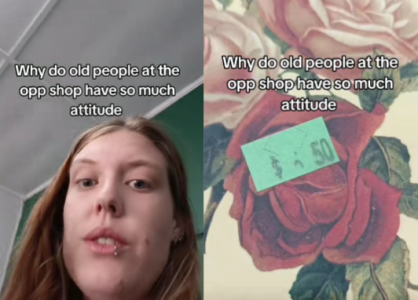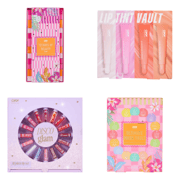If even charity shops are pricing us out…what happens next?
By
Maan
- Replies 18
A second-hand notepad. A price tag that sparked an argument. And a wave of frustration sweeping through charity shop aisles across the country.
A shopper named Casey believed she was getting a 50-cent bargain at a Salvation Army op-shop—until she reached the counter and was told it would cost $4.50.
She had already placed her coin on the counter when the volunteer corrected her.
In a clip posted to social media, she said: ‘So I walk up to the charity shop counter with this and my 50c already in hand. Pop it down, hand the lady my 50c. She goes, “Oh no, that’s $4.50.”’
Casey explained that she thought the handwritten label said 50c, as it appeared to show a semi-colon followed by the number 50.
‘I said, “Oh, I thought it said 50 cents”, and as I’m digging through my wallet, trying to grab the other coins—because I’m not going to argue with the charity shop—she goes: “I’m not going to argue with you. If you think it says 50 cents, then whatever.”’
‘I need to make sure I’m not going insane,’ Casey added.
She then asked viewers: ‘Guys, does this say 50c or $4.50?’
Despite the confusion, she paid the $4 difference, but pointed out that the issue ran much deeper than just one item.
‘You're an elderly volunteer at a Salvation Army, and it is Tuesday. I didn't come here to be gas-lit,’ she said.
‘I'm thinking (is she) actually married to Saint Vincent de Paul himself? Like you're licking his boot, babe.’
‘It's like… price it up properly then.’
‘What if I was someone who was actually struggling, on my last 50 cents, and you treated me like that at a charity shop?’
Source: TikTok/vegemitewedgie
Her story struck a nerve, as dozens of Australians chimed in with their own frustrations about rising op-shop prices.
‘With rising prices, you think op shops would've stayed cheap for that very reason so people that can't afford stuff can actually still buy stuff,’ one person wrote.
‘Is it even possible to find things that cheap in op-shops anymore?’ another added.
‘I refuse to shop in op-shops now,’ a third user commented.
‘I’m low income with four kids, I was raised on op-shop clothes myself—my mum could dress six kids on a $12 fill-a-bag—and I actually loved the hunt, but I can’t afford to shop there anymore.’
‘It’s either Kmart or Shein or Facebook as it’s cheaper. (Op-shops) aren’t targeted towards struggling people anymore which is sad.’
Another shopper pointed out: ‘I love when you go to op shops and they have Anko shirts—shirts that you buy at Kmart for around $7—for sale for $10 plus.’
Some praised regional stores for staying true to their purpose.
‘I live in an undesirable low income rural town and the op shop ladies are the best. They constantly discount already cheap stuff and give out freebies,’ one viewer said.
Casey is not the first to raise concerns.
In April, Courtney Leigh Hollins criticised a Western Australia Salvation Army for pricing a table at $400 and a couch at $240.
‘Imagine struggling in this economy and coming to the Salvos for help,’ she posted online.
‘I’m so done with huge corporations like the Salvos who make millions per year and we still have families on the streets. Charity is just a big business.’
Other eyebrow-raising price tags included a $25 single duvet, a $250 wooden cabinet, and a $600 furniture piece.
Melbourne mother-of-six Nicole Preece encountered a $280 rug filled with ‘dog or cat hair’, $28 jeans with a ‘crusty crotch’, and a karaoke machine priced at $299—with no microphone, just drum sticks sold separately for $15.
Meanwhile, Jennifer Zervas in Brisbane found a carry basket marked at $60.
‘$60 for what? Oh my God, man, are you actually serious?’ she asked.
‘I just am blown away.’

Have charity shops drifted too far from their original mission to support those doing it tough?
A shopper named Casey believed she was getting a 50-cent bargain at a Salvation Army op-shop—until she reached the counter and was told it would cost $4.50.
She had already placed her coin on the counter when the volunteer corrected her.
In a clip posted to social media, she said: ‘So I walk up to the charity shop counter with this and my 50c already in hand. Pop it down, hand the lady my 50c. She goes, “Oh no, that’s $4.50.”’
Casey explained that she thought the handwritten label said 50c, as it appeared to show a semi-colon followed by the number 50.
‘I said, “Oh, I thought it said 50 cents”, and as I’m digging through my wallet, trying to grab the other coins—because I’m not going to argue with the charity shop—she goes: “I’m not going to argue with you. If you think it says 50 cents, then whatever.”’
‘I need to make sure I’m not going insane,’ Casey added.
She then asked viewers: ‘Guys, does this say 50c or $4.50?’
Despite the confusion, she paid the $4 difference, but pointed out that the issue ran much deeper than just one item.
‘You're an elderly volunteer at a Salvation Army, and it is Tuesday. I didn't come here to be gas-lit,’ she said.
‘I'm thinking (is she) actually married to Saint Vincent de Paul himself? Like you're licking his boot, babe.’
‘It's like… price it up properly then.’
‘What if I was someone who was actually struggling, on my last 50 cents, and you treated me like that at a charity shop?’
Source: TikTok/vegemitewedgie
Her story struck a nerve, as dozens of Australians chimed in with their own frustrations about rising op-shop prices.
‘With rising prices, you think op shops would've stayed cheap for that very reason so people that can't afford stuff can actually still buy stuff,’ one person wrote.
‘Is it even possible to find things that cheap in op-shops anymore?’ another added.
‘I refuse to shop in op-shops now,’ a third user commented.
‘I’m low income with four kids, I was raised on op-shop clothes myself—my mum could dress six kids on a $12 fill-a-bag—and I actually loved the hunt, but I can’t afford to shop there anymore.’
‘It’s either Kmart or Shein or Facebook as it’s cheaper. (Op-shops) aren’t targeted towards struggling people anymore which is sad.’
Another shopper pointed out: ‘I love when you go to op shops and they have Anko shirts—shirts that you buy at Kmart for around $7—for sale for $10 plus.’
Some praised regional stores for staying true to their purpose.
‘I live in an undesirable low income rural town and the op shop ladies are the best. They constantly discount already cheap stuff and give out freebies,’ one viewer said.
Casey is not the first to raise concerns.
In April, Courtney Leigh Hollins criticised a Western Australia Salvation Army for pricing a table at $400 and a couch at $240.
‘Imagine struggling in this economy and coming to the Salvos for help,’ she posted online.
‘I’m so done with huge corporations like the Salvos who make millions per year and we still have families on the streets. Charity is just a big business.’
Other eyebrow-raising price tags included a $25 single duvet, a $250 wooden cabinet, and a $600 furniture piece.
Melbourne mother-of-six Nicole Preece encountered a $280 rug filled with ‘dog or cat hair’, $28 jeans with a ‘crusty crotch’, and a karaoke machine priced at $299—with no microphone, just drum sticks sold separately for $15.
Meanwhile, Jennifer Zervas in Brisbane found a carry basket marked at $60.
‘$60 for what? Oh my God, man, are you actually serious?’ she asked.
‘I just am blown away.’
Key Takeaways
- Casey was charged $4.50 for a notepad she thought cost 50c.
- She said the unclear price tag and staff response left her feeling gaslit.
- Other Aussies shared similar frustrations over rising op-shop prices.
- Items priced higher than retail goods have raised questions about the mission of charity shops.
Have charity shops drifted too far from their original mission to support those doing it tough?








